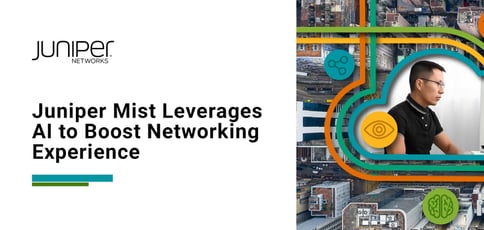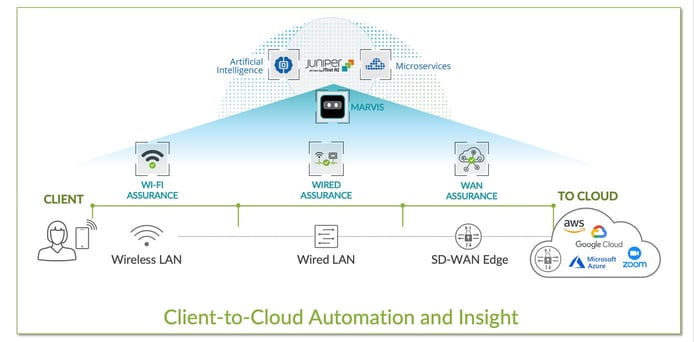
TL; DR: Networking hardware and software solutions vendor Juniper Networks acquired Mist Systems in 2019, and together, they produced Juniper Mist. Mist specializes in hosted network management that combines AI, machine learning, and data science techniques to optimize operations across wireless, wired, and SD-WAN domains. And its Virtual Network Assistant, Marvis, supports network administrators, site reliability engineers, or anyone based in network operations centers.
The financial overhead of enterprise network management is often overlooked when assessing the total cost of ownership. Organizations may not factor in the added expense as more endpoint devices seek to connect directly or via wireless into their infrastructures — from smartphones to IoT-enabled alarms.
A study by the SANS Institute found a tangled web of upfront and hidden fees that made it difficult for network managers to understand the true cost of endpoint management.
Disruptions from the COVID-19 pandemic have compelled millions of office-based employees to work from home. That scenario demonstrated that network management services must be prepared to cope with unforeseen stresses that may affect both wired and wireless network infrastructures.
Juniper Networks acquired Mist Systems in 2019, just before the COVID-19 pandemic. But the timing was just right.

California-based Juniper has been a major player in networking hardware, including routers and switches, since the 1990s. In the decades since, it has extended its reach into network management software and software-defined networking.
Juniper needed to extend its scope to the world of wireless management, hence its interest in Mist. The acquisition helped Juniper reach three key solutions areas.
Mist built a cloud-hosted, AI-driven wireless platform to make wifi networks more predictable, reliable, and measurable. The company also developed Marvis, an AI-driven conversational assistant that offers insight into network and infrastructure performance and simplifies troubleshooting.
Mist had also developed virtual Bluetooth Low Energy (BLE) technology that works in conjunction with wifi and IoT tech to deliver location-based wireless services, including indoor wayfinding, proximity notifications, traffic analytics, and asset tracking. On top of that, Mist manages all of its solutions via its hosted cloud microservices architecture.
The next frontier for Juniper Mist, as the venture is now called, is addressing the growing requirement for AI-driven SD-WAN. It predicts the requirement will gain importance as organizations start to return to post-pandemic environments where companies must support partially remote workforces.
“The world has begun its journey to AI-driven IT,” said Christian Gilby, Senior Director of Product Marketing at Juniper Mist. “It will fundamentally change how enterprise networks are managed. We believe AI can be used to take over a lot of the manual work and free up precious IT personnel to apply their expertise in more value-added ways.”
AI-Driven Management Provides Better Network Experiences
Although it’s changing, network management is still the process of administering and managing enterprise and carrier network infrastructure. The discipline provides fault-finding and analysis, performance management, network provisioning, and the all-important maintenance of service quality.
In practice, however, network management touches just about every aspect of IT service delivery. It is often as much an art as a science because no matter how well-tuned a network service may seem, business efficiency suffers if the user experience isn’t ideal.

“If you look at Juniper’s focus on the AI-driven enterprise, it’s ultimately about the delivery of great experiences, and if we haven’t delivered great experiences to customers — and indeed to their IT teams — then something’s wrong,” Christian said. “There has been a problem with that in the networking industry. That’s because the focus has been too much on network engineering and deployment, rather than the delivery of great network experiences.”
The dynamics of network management have changed as enterprise IT is less about connecting fixed endpoint devices and more about mobile and wireless compatibility.
“For instance, now network management must increasingly include IoT — anything from connected lights to IP cameras, sensors, vehicles, etc. So that brings new challenges to customers when it comes to determining how well those devices are working — and AI is the tool we leverage for that.”
Analysis Flags Performance Dips Before They Impair Productivity
The Juniper Mist solutions suite employs a combination of AI, machine learning, and data science techniques to optimize operations across the wireless access, wired access, and SD-WAN domains.
At its core, the system works by analyzing data from a range of sources connected to Juniper networks — including Juniper Mist access points, switches, and firewalls — to provide end-to-end reporting into the service level user experience.

These devices work in concert with Mist AI to optimize those experiences from client-to-cloud, including automated event correlation and root cause identification, among others.
Juniper also uses Mist AI for customer support. It is the foundational element behind Marvis, which the company believes is the industry’s first AI-backed virtual network assistant that guides IT teams via a natural language conversational interface.
“Tracing network problems is difficult because the issue could be anywhere, from client-to-cloud,” said Christian. “It could be the local wireless router, it could be the switching network, it could be the WAN, and it could be the application.”
Network management services could not traditionally look at a network’s metadata, make sense of it, and distill it to the root cause.
“That is what Juniper Mist focuses on — taking this metadata, putting it into our microservice cloud platform, analyzing it, and gaining insight into whether or not a given user or user group is having good network experience,” Christian said.
Helping Educational Institutions Upgrade Connectivity
Christian referenced Juniper Mist customer site Dartmouth College. He said he believes the distinguished research institution in New Hampshire is leading a trend in higher education to move away from on-premises WLAN controllers to cloud-hosted, AI-driven wifi solutions.
“Dartmouth College exemplifies the kind of place where wifi is a top priority,” Christian said. “Before Mist became involved in 2019, the college’s digital-first generation had pushed the campus network to its capacity, with more than 25,000 devices seeking to connect. Dartmouth has seen a six-fold increase in mobile devices in the last few years. As a result, its wifi was fairly mediocre.”
The Mist platform rolled out new wifi to all 200 buildings on campus, featuring IoT connectivity and BLE, which can enable the delivery of personalized location — including wayfinding for self-guided campus tours and proximity notifications.
“The field of AI research was founded at Dartmouth College in the mid-1950s, and students, teachers, and guests naturally expect fast, reliable wireless connectivity in such prestigious surroundings,” said Christian. “Using wireless technology, the college can now incorporate more engaging content into lesson plans.”
Dartmouth College is now exploring the possibilities of location-based services. With beacons and BLE built into the Juniper Mist Platform, the academic institution can look at providing visitors with turn-by-turn directions to their destinations, automate attendance taking in classrooms, and host augmented-reality museum tours.
Providing Businesses the AI-Driven Tools They Need
Juniper Mist encompasses the concept of what it calls AI-Driven SD-WAN. That development reflects the new era of work practice caused, in part, by the COVID-19 pandemic’s disruptive impact on workforces plus its acceleration of digital transformation programs.
“Many enterprises are adopting a new model of work organization,” Christian said. “They plan to maintain a partially remote workforce, even after employees start to physically return to their offices. That means we’ll see more satellite offices and distributed workplaces.”
According to Christian, SD-WAN gateways will connect those remote workplaces to maintain application performance and secure corporate perimeters. With these necessities in mind, SD-WAN will likely become a more crucial component of enterprise remote working strategies, with AI presenting an opportunity to take SD-WAN to the next level.
As businesses maintain continuity through this new IT normal, gaining insight into the end-to-end user experience has become even more vital.
“AI will be critical in helping organizations turn insights into actions to simplify management of distributed networks,” Christian said. “And the AI continues to learn and improve its self-driving capabilities.”
HostingAdvice.com is a free online resource that offers valuable content and comparison services to users. To keep this resource 100% free, we receive compensation from many of the offers listed on the site. Along with key review factors, this compensation may impact how and where products appear across the site (including, for example, the order in which they appear). HostingAdvice.com does not include the entire universe of available offers. Editorial opinions expressed on the site are strictly our own and are not provided, endorsed, or approved by advertisers.
Our site is committed to publishing independent, accurate content guided by strict editorial guidelines. Before articles and reviews are published on our site, they undergo a thorough review process performed by a team of independent editors and subject-matter experts to ensure the content’s accuracy, timeliness, and impartiality. Our editorial team is separate and independent of our site’s advertisers, and the opinions they express on our site are their own. To read more about our team members and their editorial backgrounds, please visit our site’s About page.



